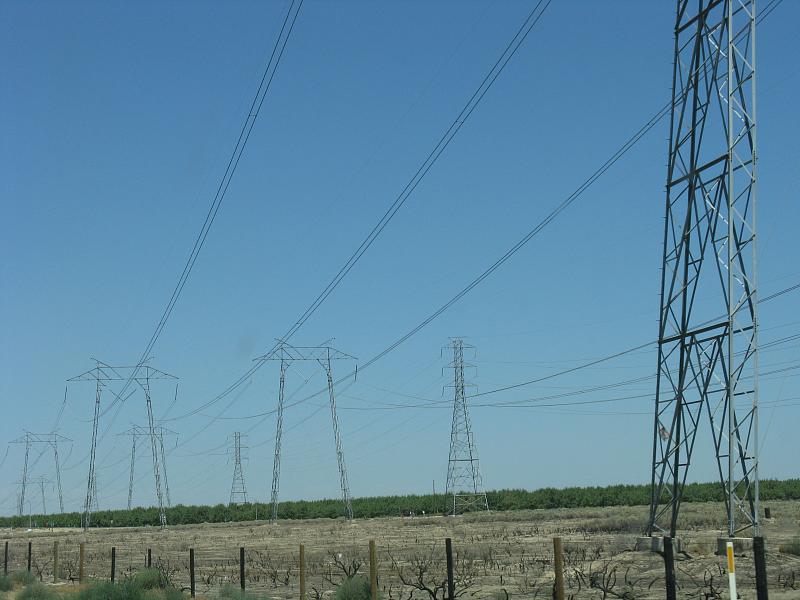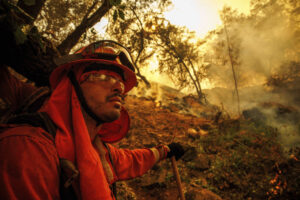Power Cut to 1 Million in California to Try to Prevent Deadly Fires
Schools and businesses close and markets run dry due as unpopular, drastic measure takes effect before forecasted high winds arrive. Steven Damron / Flickr
Steven Damron / Flickr
SONOMA, Calif. — California’s biggest utility cut power to more than a million people Wednesday for what could be days on end in the most sweeping effort in state history to prevent wildfires caused by windblown power lines.
The unpopular move sparked a run on supplies at stores and came after two years of catastrophic fires sent Pacific Gas & Electric into bankruptcy and forced it to take more aggressive steps to prevent blazes.
The drastic measure caused a wave of impacts, from long lines at supermarkets and hardware stores to backups at traffic lights that had gone dark. Schools and universities canceled classes, offices were closed and many businesses were shuttered.
With the sun shining, not a wisp of smoke in the air and only gentle breezes, the historic action was condemned by those inconvenienced.
“It’s unreasonable. There’s no wind. It’s nothing. There’s no reason why they should shut the power off,” said Joseph Pokorski, a retiree who had been drinking beers and cocktails by lantern light at the Town Square bar in Sonoma in the early morning. “They’re … closing everything down so they don’t get sued. They don’t trim the trees, so we suffer.”
More than 500,000 customers in Northern California were without power, the utility said, and about 300,000 more outages were planned later to prevent its equipment from sparking wildfires during winds forecast to build. About 2 million people were expected to be affected for up to several days.
“To everyone asking, ‘Where’s the wind? Where’s the wind?’ Don’t worry, the wind is coming. Go for a hike above 4,000 feet and you’ll feel it,” said Steve Anderson, a meteorologist with the National Weather Service’s Bay Area office. “Obviously PG&E doesn’t want to cut the power when there’s already strong winds. You want to cut the power before it happens.”
Before the lights went out in the East Bay town of Moraga, cars were lined up at gas stations and customers filled carts at the town’s only supermarket with bags of ice, canned goods, loaves of bread, breakfast cereal and water.
Lines were also long at pharmacies and hardware stores, where emergency supplies were running low.
“Do you have any lanterns?” a concerned Elma Lear asked at Moraga Hardware and Lumber. “Or candles?”
The store was out of both and had also run out of batteries and coolers — even ultra-pricey Yeti coolers that cost as much as $400, owner Bill Snider said.
On Tuesday, the store sold 500 flashlights. Other high-demand items were extension cords, propane tanks for barbecues and butane for camping stoves. Generators were almost impossible to find.
Lear, who had stocked up on nonperishable food, cash and filled her gas tank, was directed to a home decor shop nearby where she had to fork over $40 for long lasting beeswax candles.
“I’m going to bite the bullet,” she said.
The utility planned to shut off power in parts of 34 northern and central California counties to reduce the chance of fierce winds knocking down or toppling trees into power lines during a siege of dry, gusty weather.
Gusts of 35 mph to 45 mph (56-72 kph) were forecast to sweep a vast swath of the state, from the San Francisco Bay Area to the agricultural Central Valley and especially in the Sierra Nevada foothills, where a November wildfire blamed on PG&E transmission lines killed 85 people and virtually incinerated the town of Paradise.
So far, wildfires have only burned a tiny fraction of the acreage burned in recent years. Through Sunday, only 63 square miles (163 square kilometers) had burned, compared to nearly 1,000 square miles (2,500 square kilometers) at the same time last year and an average of about half that figure in the past five years.
Very few fires were currently burning.
Deliberate outages could become the new normal in an era in which scientists say climate change is leading to fiercer blazes and longer fire seasons.
The winds will be the strongest and most widespread the region has seen in two years, and given the scope of the danger, there was no other choice but to stage the largest preventive blackout in state history, PG&E said.
“This is a last resort,” said Sumeet Singh, head of the utility’s Community Wildfire Safety Program.
Gov. Gavin Newsom said people should be outraged by PG&E’s move.
“No one is satisfied with this, no one is happy with this,” he said Tuesday.
The utility needs to upgrade and fix its equipment so massive outages are not the norm going forward, he said.
The outages came as residents in the region’s wine country north of San Francisco marked the two-year anniversary of deadly wildfires that killed 44 and destroyed thousands of homes. San Francisco is the only county in the nine-county Bay Area where power will not be affected.
It could take as many as five days to restore power after the danger has passed because every inch of power line must be checked to make sure it isn’t damaged or in danger of sparking a blaze, PG&E said.
To the south, Southern California Edison was considering power shut-offs to nearly 174,000 customers in nine counties as Santa Ana winds were predicted Thursday. San Diego Gas & Electric has notified about 30,000 customers they could lose power in backcountry areas.
The cutbacks followed a plan instituted after deadly wildfires — some blamed on downed PG&E transmission lines — destroyed dozens of lives and thousands of homes in recent years and forced the utility into bankruptcy over an estimated $30 billion in potential damages from lawsuits.
The outages Wednesday weren’t limited to fire-prone areas because the utilities must turn off entire distribution and transmission lines to much wider areas to minimize the risk of wildfires.
Classes were canceled for thousands of schoolchildren and at the University of California, Berkeley, Sonoma State University and Mills College.
Hospitals would operate on backup power, but other systems could see their generators fail after a few days. Outages even posed a threat that fire hydrants wouldn’t work at a time of extreme fire danger.
Counties activated their emergency centers and authorities urged people to have supplies of water for several days, to keep sensitive medicines such as insulin in cool places, to drive carefully because traffic lights could be out, to have a full gas tank for emergencies and to check the food in freezers and refrigerators for spoilage after power is restored.
PG&E set up about 30 community centers offering air conditioning, restrooms, bottled water and electronic charging stations during daylight hours.
___
Melley reported from Los Angeles. Associated Press writers Janie Har and Olga Rodriguez in San Francisco, Jocelyn Gecker in Moraga, Don Thompson in El Dorado Hills, Haven Daley in Oakland, and Christopher Weber and John Antczak in Los Angeles contributed to this story.
Your support is crucial…With an uncertain future and a new administration casting doubt on press freedoms, the danger is clear: The truth is at risk.
Now is the time to give. Your tax-deductible support allows us to dig deeper, delivering fearless investigative reporting and analysis that exposes what’s really happening — without compromise.
Stand with our courageous journalists. Donate today to protect a free press, uphold democracy and unearth untold stories.






You need to be a supporter to comment.
There are currently no responses to this article.
Be the first to respond.